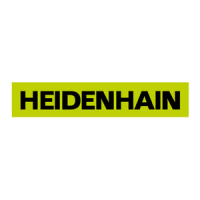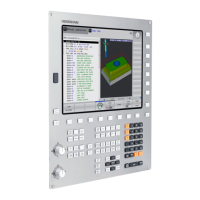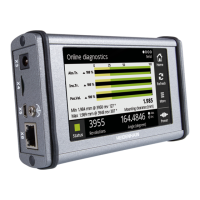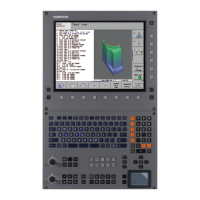December 2001 Touch Probe 6 – 361
The feed rate in normal direction determines the maximum oscillation
amplitude and maximum scanning feed rate:
If MP6230 is too low, the machine’s dynamic capabilities will not be fully
exploited and the scanning feed rate will also be too low.
If MP6230 is too high, the oscillation amplitude is too large. In this case the
stylus will visibly lift off from the contour and “tap” the surface of the
workpiece, and the scanning feed rate will no longer increase.
7
77
7 In MP6240, specify the maximum stylus deflection.
MP6240 depends on the length of the stylus being used.
MP6240 specifies the maximum travel by which the stylus retracts on inside
corners. If the touch probe is not clear of the surface after the stylus backs off
by the travel defined in MP6240, it will retract in the positive direction of the
probe axis (e.g. Z). Digitizing continues as soon as the touch probe is clear. If
the input value is too small, the touch probe may get caught up in an endless
repetitive attempt to come free from an inside corner.
7
77
7 With MP6260, select whether an M90 is appended to every NC block in the
transmitted digitized data (See "Contouring Behavior” on page 6 – 152).
7
77
7 With MP6270, specify the number of decimal places to which the
coordinates are output.
MP6210 Number of oscillations in normal direction per second
Input: 0 to 65.535 [1/s]
MP6230 Feed rate in normal direction
Input: 0 to 1000 [mm/min]
MP6240 Maximum deflection of the stylus
Input: 0 to 10.000 [mm]
MP6260 Output of M90 in NC blocks with digitized data
Input: 0: No output of M90
1: Output of M90 in every NC block
MP6270 Rounding of decimal places
Input: 0: Output in 0.001-mm steps (1 µm)
1: Output in 0.01-mm steps (10 µm)
2: Output in 0.0001-mm steps (0.1 µm)
Scanning cycles Its direct access to the position control loop of the TNC controller enables the
touch probe to measure values very rapidly (3 to 5 values per second). This
results in a scanning feed rate of 180 to 300 mm/min at a programmed probe
point interval of 1 mm.
Three scanning cycles are available for digitizing:
n Range
n Meander
n Contour lines
The “range” cycle defines the cuboid scanning range and the file in which the
digitized data is stored. You can file the digitized data in the program memory
of the control or on a PC.

